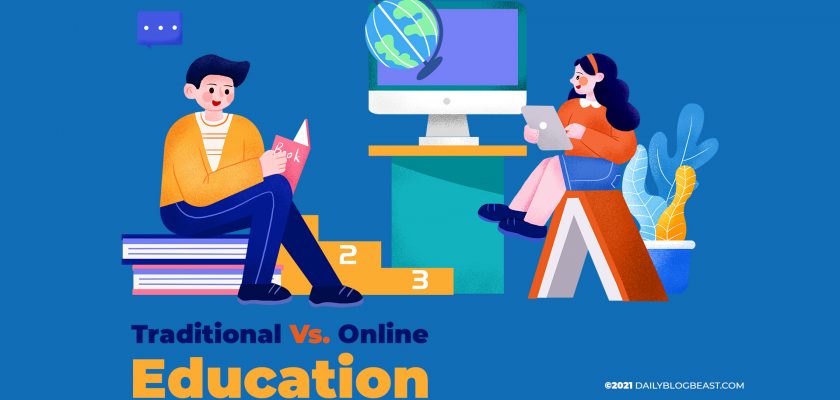When determining online and conventional schooling, it’s necessary to think about learning preferences, settings, and technological specifications. When students discuss online vs. traditional education, they can only consider the most apparent distinction between the machine and the classroom. Many other factors may have a massive effect on a student’s potential to excel.
Online courses and training have been increasingly common in recent years, with an increasing number of institutes and businesses offering them. Despite the prevalence of online education, a sizable portion of the population actively avoids it, primarily due to misunderstanding.
Around the same time, conventional (classroom) teaching is battling back and seeking to implement newer methods of maintaining learners’ attention amid the increasing prevalence of online classes. A coin still has two sides. For some people, online preparation is the best option, and for others, classroom training is the best option.
College attendance is not necessary nowadays. Previously you could only adapt the timetable set by universities. With online classes, students will now build their own schedules.

The Difference Between Conventional And Online Education:
Several of these considerations will be discussed in this article, including
- Styles of learning
- Classroom setting
- Technology
- Tuition
- Pacing
Styles of Learning:
Usually, online learning types are preferred in online learning. When juggling other commitments, online students are supposed to be self-directed in achieving their academic goals. Specific learning patterns are also favored in some courses over others. Many that focus heavily on visual information, for example, may prefer visual learners. Others use recorded audio lectures to provide content, which may be beneficial for auditory learners.
Communication options in online learning:
- Message boards
- Instant messaging
- Video conferencing
- Chat rooms
On the other hand, traditional classes often appeal to students with collaborative learning styles, predominantly auditory and kinesthetic learners. On the other hand, standard learning experiences provide space for face-to-face contact both within and outside the classroom. Furthermore, peers on campus may provide social and academic support at a brick-and-mortar school.
Classroom Settings:
In a typical class, a group of students meets at a given time and location to study. Students may engage with the teacher during office hours by attending seminar review sessions, individual research groups with friends, or after class or office hours. Teacher-led instruction is the most common type of training at conventional colleges, in which a professional lecturer teaches on the topic of his or her expertise.
Few online classes use the same format as traditional classrooms, with synchronous online learning sessions and question-and-answer sessions that double as teacher office hours. On the other hand, such online courses offer students the right to learn when and when it is most convenient. In online programs, the teaching style is more user-centered. Students can have differing degrees of influence over their learning speed and whether they enter class, depending on the course.
Technological Concerns:
Students must require basic computer literacy to do well in online courses. Similarly, the teacher must have an idea about how to incorporate these resources into lessons. The teacher must provide lessons to students that how they can regulate the computers or devices in the first place. Web sites, webinars, software programs, webcasts, search engines, and social networking are some of the media that can be used in online classes in addition to the contact strategies previously described.
Although conventional courses will be held in the classroom, students and teachers may also need specific technical expertise to use document development tools, perform Internet-based analysis, and access other technology services. As a result, standard classrooms would not exclude students or teachers from learning how to use technology and incorporating it into their educational programs.
Both online and in-person instructional services have similarities and variations. Depending on their interests and learning levels, prospective students will select between them.
Tuition:
While some schools charge online students the same as on-campus students, many schools charge different tuition and fees for their distance learning programs. Tuition is often arranged on a per-credit basis or paid at a flat rate that covers the course’s necessary expenses. Some schools exclude fees that do not extend to online students (such as lab fees) or incorporate fees that help them support the online curriculum’s technical framework.
Pacing:
Students must take classes during the semester, date, and time they are delivered in a typical on-campus environment. Online courses also have greater flexibility since they are not held in a physical venue. In two ways, this is right. Many colleges provide self-pacing, allowing students to learn content on their own time using college tools, allowing them to work through their busy work and life schedules. Other schools use a more conventional approach, ‘conducting’ online courses on a fixed timetable but with varying start times and lengths. Students can opt for a 12-week course or a 5.5-week accelerated course, for example.
With these versatile opportunities, online students usually finish their degrees earlier than their on-campus counterparts; full-time online students with an advanced program could graduate in around 2.5 years, while conventional students require an average of 5 years. Students who study part-time in an online degree program and complete it around their work schedules, on the other hand, typically take longer.

